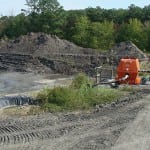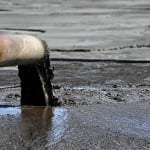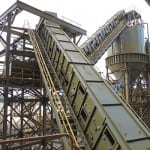The materials left over from coal combustion processes are called coal combustion by-products or coal combustion residuals (CCRs) if the material is recycled for another process. An earlier article (“Constructing and Managing Coal Ash Landfills,” January/February 2012) discussed the process of sluicing the waste ash to a settling pond to collect the ash for permanent storage or until the ash is recycled. The sluicing operation creates a mixture of water and ash at some collection point between the boiler and the pond.
The traditional approach to operating ash ponds has been to create a large settling basin where the ash drops out of the stream and water is decanted and returned to the power house area for additional sluicing, with the goal being inexpensive removal of waste from the boiler operation. The mixture is transported to the settling point or pond inlet by pumping it through a pipeline, a method that is usually much less expensive than trucking or dry conveying. Some plants may manage both fly ash and bottom ash with this method, whereas others may manage only the heavier bottom ash in this manner. Once the ash and water mixture reaches the pond, it may be manually distributed by moving the discharge end of the pipe to enhance settling, or the pipe may be stationary and the mixture will seek its own path (Figure 1).
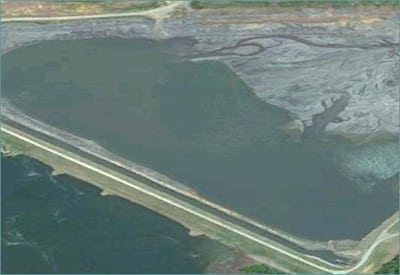
1. This large settling pond has no control of flow. Note the large delta of ash near the inlet. Courtesy: Skelly and Loy
As a rule of thumb, settling ponds should be designed such that the length is approximately twice the width. This configuration enhances settling. However, many of these ponds are constructed with an elevated dike, and they are allowed to fill and consolidate over time. As the impoundment fills, another dike is constructed above the first, creating additional storage volume. The new dike would likely be set back from the original for stability considerations. In this manner, a plant can continue to place ash within the original footprint allocated for waste management, which minimizes operating costs.
The ideal configuration (length = 2 x width) for a settling pond is more likely to be used when recycling ash or when dry disposal is the method of final waste management. Plants focused on marketing the waste material as construction aggregate or for other end uses, or plants with restricted pond space, are more apt to establish a pond configuration that offers ease of capture and removal of the ash material once it is settled.
Ash Removal Considerations
Removal of settled ash material from a pond is accomplished by dredging, either with a wet dredge or through excavation by more conventional equipment. A wet dredge is a barge-mounted cutter head with a pump that drags flexible pipe as it cuts and sluices the removed material to another area for settling, much like the primary pond. The recovery method described is popular because it uses conventional equipment owned by a typical contractor or managed by plant employees. A word of caution: Study the specific needs of your facility, the available markets and disposal requirements that apply, and the available pond area to formulate your specific recovery plan (Figure 2).
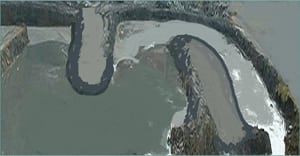
2. This settling pond has dikes to control flow and allow for ease of cleaning. Courtesy: Skelly and Loy
When laying out a settling pond for recovery of solids, accessibility of the settled solids is an obvious consideration. If a long-reach track hoe or similar equipment is to be used, then the access requirements and the dike design will be different than those required by a dredge. The dikes perform several functions, such as directing the flow of water and ash through a much longer path from inlet to discharge points, thus greatly enhancing retention time and settling of solids. Dikes also offer an opportunity for equipment to access channels established between the dikes so that these channels can be regularly cleaned even while the pond is in operation.
The width and stability of dikes are very important for safety when operating excavating and hauling machinery. The owner must create a safe environment for the dredging operation and avoid undermining the structural integrity of the dikes. There are options such as sheet piling that can be used to protect certain areas that may be susceptible to stability problems. Regardless, a good safety training program for operators of heavy equipment is critical.
Not surprisingly, the heavier, larger ash particles drop out of the stream earlier, and recovery operations should be planned accordingly. In other words, cleaning the channel end closest to the pond inlet often yields larger material.
If material is to be dredged and hauled to the owner’s solid waste landfill, the ash will likely have to be dried before hauling, so an ample lay-down area will be required for air drying. The amount of material that is disposed in a landfill can be reduced by opportune use of the waste as drainage media, low-permeability top dressing, or other means to offset the need for purchased materials. This approach will not only reduce overall operating costs for the facility but also will lengthen the life of the owner’s landfill or pond areas. Some processing may be required to utilize these materials in a beneficial way, but it is usually well worth the additional cost (Figure 3).
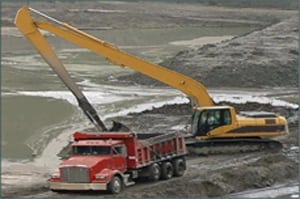
3. Cleaning ash from a pond using long-reach hoe and loading into truck for transportation to a location where the ash will be laid out for drying. Courtesy: Skelly and Loy
Usage Affects Pond Operation
Understanding the types of ash produced at a facility and how those materials might be reused or recycled within the community is of great benefit to the overall operation of the settling pond. Some ash may be captured from the surface of the water, while other ash may readily settle out and must be excavated.
Physical and chemical characteristics of the CCRs will dictate its value in the lifecycle of the end product. Similarly, this type of information will dictate how and where the material is captured within the pond complex. CCR characteristics could also indicate the cost of recovery, thus impacting total costs for recycling applications whether the material is used in-house or marketed to other end users.
Maintenance and Inspection
In addition to these considerations, the owner of any pond must establish criteria and responsibilities for regular inspection and maintenance of the facility. Qualified, conscientious personnel should perform thorough, documented inspections and compare results to previous work and accepted standards. Understanding the design of the pond and the detrimental effects of dysfunctional features is very important to the inspection process, but it is also important to promptly address negative findings. Owners, consultants, and regulators all play a part in ensuring safety and viability of these facilities.
A strong pond maintenance program based on trust and communications can lead to many years of value added to the operation of a power station.
—Rex A. Peppler, PE is engineering manager for Skelly and Loy Inc.’s Mining Service Group, located in Wise, Va. The article was edited by Dr. Robert Peltier, PE.








